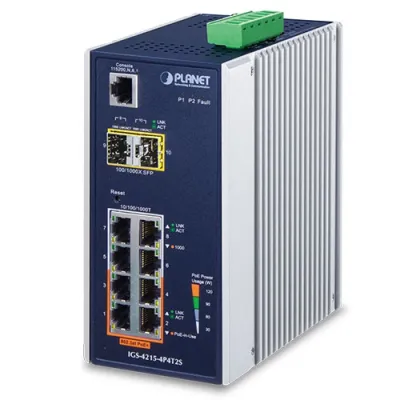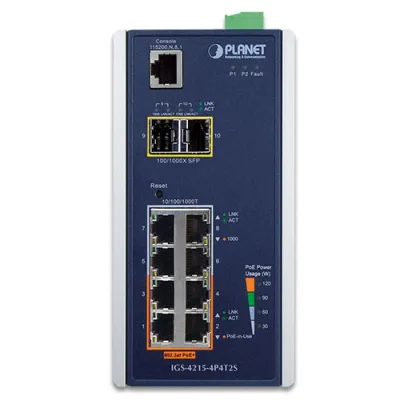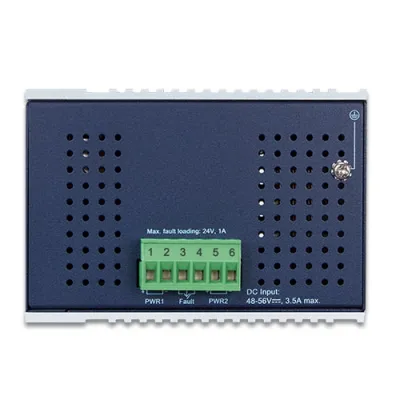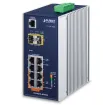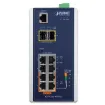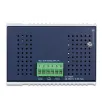Planet - IGS-4215-4P4T2S - IP30 Industrial L2/L4 4-Port 10/100/1000T 802.3at PoE + 4-Port 10/100/1000T + 2-Port 100/1000X SFP Managed Switch
Ideal, Cost-effective, Manageable PoE Solution for Hardened Environment
The IGS-4215-4P4T2S is an L2/L4 Managed Gigabit PoE+ Switch designed to be installed in heavy industrial environments and comes equipped with industrial-grade, DIN-rail type featuring Planet’s intelligent PoE functions to improve the availability of critical business applications. The unit provides IPv6/IPv4 dual stack management and built-in L2/L4 Gigabit switching. The unit provides 4 10/100/1000BASE-T ports featuring 30-watt 802.3at PoE+, 4 Gigabit copper ports and an additional 2 100/1000BASE-X SFP fiber slots for data and video uplinks. The IGS-4215-4P4T2S can operate reliably without affecting its performance. The unit comes with a total power budget of up to 144 watts for different kinds of PoE applications and operating temperatures ranging from -40 to 75°C in a rugged IP30 metal housing.
Smart Management PoE Features
The IGS-4215-4P4T2S features the following smart PoE management features:
- PD alive check
- Scheduled power recycling
- PoE schedule
- PoE usage monitoring
Intelligent Power Activation
The IGS-4215-4P4T2S can be configured to monitor connected PD (Powered Device) status in real time via ping action. Once the PD stops working and responding, the IGS-4215-4P4T2S will resume the PoE port power and bring the PD back to work. It will greatly enhance the network reliability through the PoE port resetting the PDs power source and reducing administrator management burden.
Scheduled Power Rebooting
The IGS-4215-4P4T2S allows each of the connected PoE IP cameras or PoE wireless access points to reboot at a specific time each week. This reduces the chances of IP camera or AP from crashing due to buffer overflow.
Energy-Efficient Features
The IGS-4215-4P4T2S offers many energy-efficient PoE management features. The PoE schedule function helps you to enable or disable PoE power feeding for each PoE port during specified time intervals and it is a powerful function that helps SMBs or enterprises save power and resources. It also increases security by powering off PDs that should not be in use during non-business hours.
PoE Usage Monitoring and Intelligent LED Indicator for Real-time PoE Usage
The IGS-4215-4P4T2S enables administrators to monitor the status of the power usage of the connected PDs in real time. This improves the efficiency of the IGS-4215-4P4T2S helping users to monitor the current status of PoE power usage.
Environmentally Hardened Design
With its IP30 aluminum industrial case, the IGS-4215-4P4T2S provides a high level of immunity against electromagnetic interference and heavy electrical surges which are usually found on plant floors or in curb-side traffic control cabinets without air conditioner. The units range from -40 to 75°C and can be placed in almost any difficult environment.
IPv6/IPv4 Dual Stack Management
With the ability to support IPv6 and IPv4 protocols, the IGS-4215-4P4T2S helps system integrators step into the IPv6 era without the need to replace or overhaul an existing network.
Robust Layer 2 Features
The IGS-4215-4P4T2S can be programmed for advanced switch management functions such as dynamic port link aggregation, 802.1Q VLAN, Q-in-Q VLAN, Multiple Spanning Tree Protocol (MSTP), Loop and BPDU Guard, IGMP Snooping, and MLD Snooping. Via the link aggregation, the IGS-4215-4P4T2S allows the operation of a high-speed trunk to combine with multiple ports such as a 16Gbps fat pipe, and supports fail-over as well. Also, the Link Layer Discovery Protocol (LLDP) is the Layer 2 protocol included to help discover basic information about neighboring devices on the local broadcast domain.
Powerful Traffic Management Features
The IGS-4215-4P4T2S is features robust QoS features and powerful traffic management that enhance services to business-class data, voice, and video solutions. The functionality includes broadcast/multicast/unicast storm control, per port bandwidth control, 802.1p/CoS/IP DSCP QoS priority and remarking. It guarantees the best performance in VoIP and video stream transmission, and empowers the enterprises to take full advantage of the limited network resources.
User-Friendly and Secure Management
The IGS-4215-4P4T2S is equipped with web, Telnet and SNMP management interfaces. With its built-in web-based management interface, the IGS-4215-4P4T2S offers an easy-to-use, platform-independent management and configuration facility. By supporting the standard SNMP, the switch can be managed via any standard management software. For text-based management, the switch can be accessed via Telnet. Moreover, the IGS-4215-4P4T2S offers secure remote management by supporting SSH, SSL and SNMP v3 connections which encrypt the packet content at each session.
Advanced Network Security
PLANET’s IGS-4215-4P4T2S offers a comprehensive IPv4/IPv6 Layer 2 to Layer 4 Access Control List (ACL) for enforcing security to the edge. Its protection mechanism also comprises 802.1X port-based user and device authentication, which can be deployed with RADIUS to ensure the port level security and block illegal users. With the protected port function, communication between edge ports can be prevented to guarantee user privacy. Furthermore, the IGS-4215-4P4T2S also provides DHCP snooping, IP source guard and dynamic ARP inspection functions to prevent IP snooping from attack and discarded ARP packets with invalid MAC address. The network administrators can now construct highly-secure corporate networks with considerably less time and effort than before.
Long Distance Solution
With its two built-in mini-GBIC slots, the IGS-4215-4P4T2S offers SFP auto-detection and dual speed as it features 100BASE-FX and 1000BASE-SX/LX SFP (Small Form-factor Pluggable) fiber transceivers to uplink to backbone switch. The distance can be extended from 550 meters to 2 kilometers (multi-mode fiber) and up to 10/20/30/40/50/60/70/120 kilometers (single-mode fiber or WDM fiber). They are well suited for applications within the enterprise data centers and distributions.
Intelligent SFP Diagnosis Mechanism
The IGS-4215-4P4T2S supports SFP-DDM (Digital Diagnostic Monitor) function helping network administrator monitor real-time parameters of the SFP, such as optical output power, optical input power, temperature, laser bias current, and transceiver supply voltage.
| Hardware Specifications | |
| Copper Ports | 8 10/100/1000BASE-T RJ45 auto-MDI/MDI-X ports |
| SFP/mini-GBIC Slots | 2 1000BASE-SX/LX/BX SFP interfaces (Port-9 and Port-10) Compatible with 100BASE-FX SFP |
| PoE Injector Port | 4 ports with 802.3af/802.3at PoE injector function (Port-1 to Port-4) |
| Console | 1 x RS232-to-RJ45 serial port (115200,8, N, 1) |
| Switch Architecture | Store-and-Forward |
| Switch Fabric | 20Gbps/non-blocking |
| Switch Throughput@64 bytes | 14.8Mpps @64 bytes |
| MAC Address Table | 8K entries |
| Shared Data Buffer | 4.1 megabits |
| Flow Control | IEEE 802.3x pause frame for full-duplex Back pressure for half-duplex |
| Jumbo Frame | 10 Kbytes |
| Reset Button | < 5 sec: System reboot > 5 sec: Factory default |
| LED | 3 x LED for System and Power: – Green: DC Power 1 – Green: DC Power 2 – Green: Power Fault 2 x LED for PoE Copper Port (Port-1~Port-4): – Green: LNK/ACT – Orange: PoE-in-use 2 x LED for 10/100/1000T Copper Port (Port-5~Port-8): – Green: LNK/ACT – Orange: 1000Mbps 2 x LED for per mini-GBIC interface (Port-9 and Port-10) – Green: LNK/ACT – Orange: 1000Mbps 4 x LED for PoE Power Usage (W) – Orange: 30, 60, 90 and 120W |
| Connector | Removable 6-pin terminal block Pin 1/2 for Power 1; Pin 3/4 for fault alarm; Pin 5/6 for Power 2 |
| Alarm | One relay output for power failure. Alarm relay current carry ability: 1A @ 24V AC |
| Power Requirements | 48~56V DC, 3.5A (max.) |
| Power Consumption/ Dissipation | 5.04 watts, 17.1BTU (Standby without PoE function) 8.96 watts, 30.5 BTU (Full loading without PoE function) 152.96 watts, 521.8 BTU (Full loading with PoE function) |
| Dimensions (W x D x H) | 161 x 107 x 72 mm |
| Weight | 1004g |
| ESD Protection | 6KV DC |
| Enclosure | IP30 aluminum case |
| Installation | DIN-rail kit and wall-mount ear |
| Power over Ethernet | |
| PoE Standard | IEEE 802.3af/802.3at Power over Ethernet PSE |
| PoE Power Supply Type | End-span |
| PoE Power Output | IEEE 802.3af Standard – Per port 48V~56V DC (depending on the power supply), max. 15.4 watts IEEE 802.3at Standard – Per port 50V~56V DC (depending on the power supply), max. 36 watts |
| Power Pin Assignment | 1/2(+), 3/6(-) |
| PoE Power Budget | 144 watts (depending on power input) |
| Max. Number of Class 2 PDs | 4 |
| Max. Number of Class 3 PDs | 4 |
| Max. Number of Class 4 PDs | 4 |
| Layer 2 Functions | |
| Port Mirroring | TX/RX/Both Many-to-1 monitor |
| VLAN | 802.1Q tagged-based VLAN Up to 256 VLAN groups, out of 4094 VLAN IDs 802.1ad Q-in-Q tunneling (VLAN stacking) Voice VLAN Protocol VLAN Private VLAN (Protected port) GVRP Management VLAN |
| Link Aggregation | IEEE 802.3ad LACP and static trunk Supports 4 groups with 4 ports per trunk |
| Spanning Tree Protocol | IEEE 802.1D Spanning Tree Protocol (STP) IEEE 802.1w Rapid Spanning Tree Protocol (RSTP) IEEE 802.1s Multiple Spanning Tree Protocol (MSTP) STP BPDU Guard, BPDU Filtering and BPDU Forwarding |
| IGMP Snooping | IPv4 IGMP snooping v2, v3 IGMP querier Up to 256 multicast groups |
| MLD Snooping | IPv6 MLD snooping v2, v3, up to 256 multicast groups |
| Access Control List | IPv4/IPv6 IP-based ACL/MAC-based ACL IPv4/IPv6 IP-based ACE/MAC-based ACE |
| QoS | 8 mapping IDs to 8 level priority queues – Port number – 802.1p priority – DSCP/IP precedence of IPv4/IPv6 packets Traffic classification based, strict priority and WRR Ingress/Egress Rate Limit per port bandwidth control |
| Security | IEEE 802.1X port-based authentication Built-in RADIUS client to cooperate with RADIUS server RADIUS/TACACS+ authentication IP-MAC port binding MAC filtering Static MAC address DHCP snooping and DHCP Option82 STP BPDU guard, BPDU filtering and BPDU forwarding DoS attack prevention ARP inspection IP source guard Storm control support – Broadcast/unknown unicast/unknown multicast |
| Management Functions | |
| Basic Management Interfaces | Web browser, Console,Telnet, SNMP v1, v2c, v3 Firmware upgrade by HTTP/TFTP protocol through Ethernet network Configuration upload/download through HTTP/TFTP Remote/local syslog System log LLDP protocol SNTP PLANET Smart Discovery Utility |
| Secure Management Interfaces | SSH, SSL, SNMP v3 |
| SNMP MIBs | RFC 1213 MIB-II RFC 1215 Generic Traps RFC 1493 Bridge MIB RFC 2674 Bridge MIB Extensions RFC 2737 Entity MIB v2 RFC 2819 RMON (1, 2, 3, 9) RFC 2863 Interface Group MIB RFC 3635 Ethernet-like MIB |
| Standards Conformance | |
| Regulatory Compliance | FCC Part 15 Class A, CE |
| Stability Testing | IEC 60068-2-32 (free fall) IEC 60068-2-27 (shock) IEC 60068-2-6 (vibration) |
| Standards Compliance | IEEE 802.3 10BASE-T IEEE 802.3u 100BASE-TX/100BASE-FX IEEE 802.3z Gigabit SX/LX IEEE 802.3ab Gigabit 1000BASE-T IEEE 802.3x Flow Control and Back Pressure IEEE 802.3ad Port Trunk with LACP IEEE 802.1D Spanning Tree Protocol IEEE 802.1w Rapid Spanning Tree Protocol IEEE 802.1s Multiple Spanning Tree Protocol IEEE 802.1p Class of Service IEEE 802.1Q VLAN Tagging IEEE 802.1x Port Authentication Network Control IEEE 802.1ab LLDP RFC 768 UDP RFC 793 TFTP RFC 791 IP RFC 792 ICMP RFC 2068 HTTP RFC 1112 IGMP v1 RFC 2236 IGMP v2 RFC 3376 IGMP v3 RFC 2710 MLD v1 RFC 3810 MLD v2 |
| Environment | |
| Operating | Temperature: -40 ~ 75 degrees C Relative Humidity: 5 ~ 95% (non-condensing) |
| Storage | Temperature: -40 ~ 85 degrees C Relative Humidity: 5 ~ 95% (non-condensing) |

